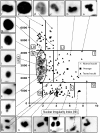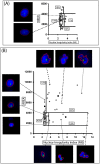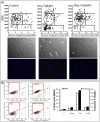Nuclear morphometric analysis (NMA): screening of senescence, apoptosis and nuclear irregularities
- PMID: 22905142
- PMCID: PMC3414464
- DOI: 10.1371/journal.pone.0042522
Nuclear morphometric analysis (NMA): screening of senescence, apoptosis and nuclear irregularities
Abstract
Several cellular mechanisms affect nuclear morphology which can therefore be used to assess certain processes. Here, we present an analytic tool to quantify the number of cells in a population that present characteristics of senescence, apoptosis or nuclear irregularities through nuclear morphometric analysis. The tool presented here is based on nuclear image analysis and evaluation of size and regularity of adhered cells in culture. From 46 measurements of nuclear morphometry, principal component analysis filtered four measurements that best separated regular from irregular nuclei. These measurements, namely aspect, area box, radius ratio and roundness were combined into a single nuclear irregularity index (NII). Normal nuclei are used to set the parameters for a given cell type, and different nuclear phenotypes are separated in an area versus NII plot. The tool was validated with β-gal staining for senescence and annexin or caspases inhibitor for apoptosis as well as several treatments that induce different cellular phenotypes. This method provides a direct and objective way of screening normal, senescent, apoptotic and nuclear irregularities which may occur during failed mitosis or mitotic catastrophe, which may be very useful in basic and clinical research.
Conflict of interest statement
Figures





References
Publication types
MeSH terms
Substances
LinkOut - more resources
Full Text Sources
Other Literature Sources

